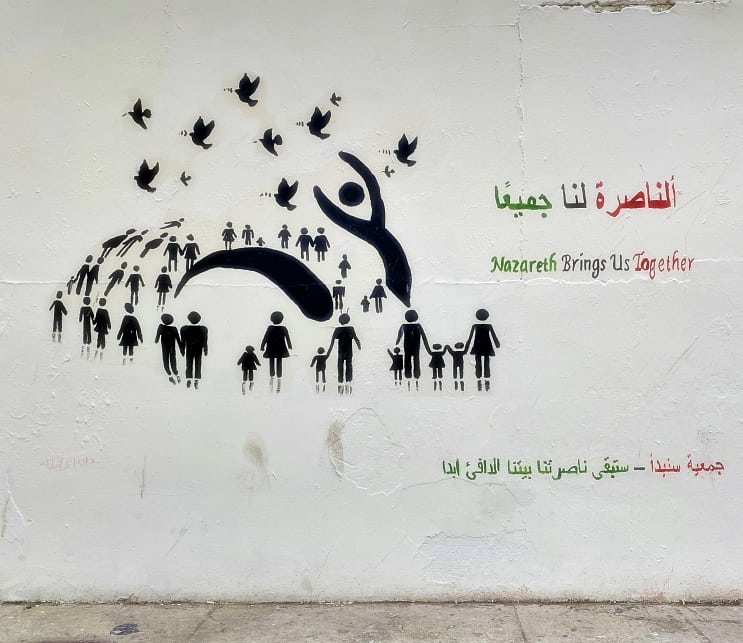
Seriously, I can’t get a better title. It isn’t easy to finish reading this blog given the time of the year. But if you do, text me a better headline.
Are you a pilgrim? Have you made a pilgrimage? I hope you discover yourself as one. And I pray that you get an opportunity to go to the Holy Land on a pilgrimage – or meet Jesus on your journey wherever you are.
I was part of the Goan Chaplaincy UK pilgrimage group to the Holy Land (November 2022). It meant walking along the footsteps of Jesus and bringing holy scripture and sacred places alive through faith.
Many things happen on a pilgrimage which results in a spiritual experience. Because of the newness, the pilgrim sees things in a different light. I have noted a few such moments. Each pilgrim has their spiritual renewal.
The Nativity Church – Mystery, Mess & Multitudes
Five groups own the present-day Church of Nativity: Greek Orthodox, Roman Catholics, Armenian, Syrian and Coptic. Each has a particular time and a rite while operating in the church. It is a sensitive scenario – a fight can erupt between these leaders if things are done differently than agreed between the five parties. Don’t do it during worship if you are told not to sing. Full stop. The parties maintain the status quo always.
How the search for Jesus’ birthplace began? Queen Helena, the mother of Emperor Constantine, is regarded as the first archaeologist of the holy land. Queen Helena started to search the sacred places and relics in the fourth Century, building churches on significant sites in Jesus’ life.
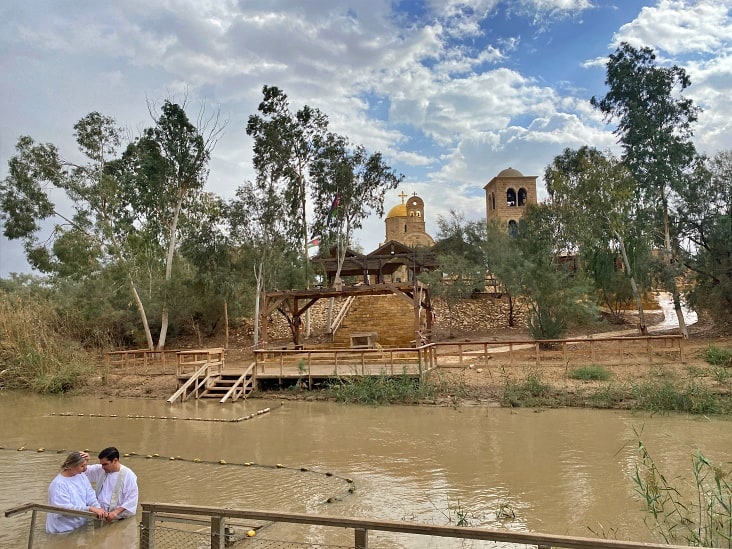
It was a miracle that the sixth-century church of nativity remained intact and escaped destruction by the Persian invaders. Some testify that the invaders saw the painting of the Magi with Persian dress and thought the structure was connected to their land. The locals profess that Mary appeared during that time. The soldiers could not see the church and the altar. Another tradition has a different story about why the church escaped destruction. Some flies started to bite the soldiers, who had to flee the place. It’s a place of miraculous intervention – the birth of Jesus.
You need to be prepared to see a different scene other than serenity. We had to wait in line for over two hours to get to touch the spot of Jesus’ birth. It was crowded, people turning impatient and pushing their way through the narrow passage. Some capture the memories on cell phones or cameras, while others are silent amid noise and chaos. It is a place of sacred moments.
Anything can happen. Be ready. One man dressed in traditional attire walked towards our group. He distributed 3×3 inch blank papers. People wrote their prayer intentions on it. After 10 minutes, he came again to collect it, and people offered him money. And we had our Israeli guide instruct us a moment later, “Don’t give money to him. It’s for his community.”
Amidst the chaos and deception, I felt new could still be born.
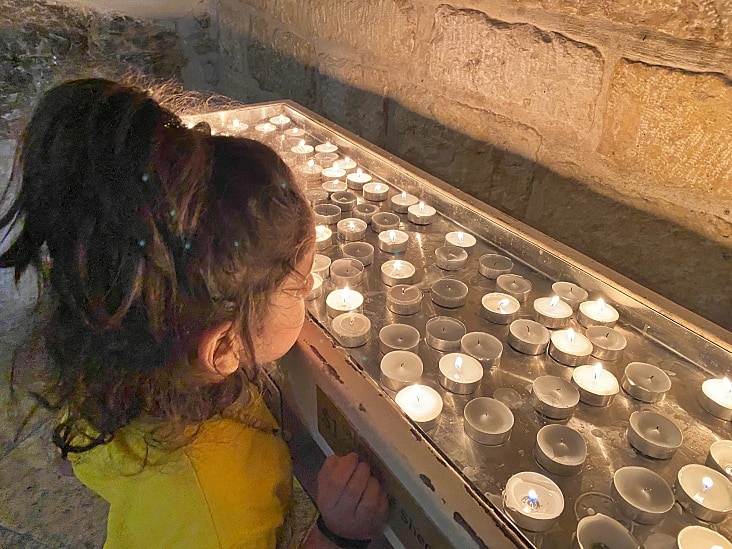
How to look at the birthplace of Jesus in a cave – a stable
We went to the Shepherds’ field to see an actual cave, as pilgrims would find it difficult to imagine the place of the nativity church as a birth in a cave. It was to give the pilgrims an idea of the ancient stable or the cave where Jesus’ birth took place.
For the shepherds, the most priced possession is the sheep. The sheep are kept in the innermost part of the cave. The middle area for the kitchen area, and the cave entrance is the dining area. The children and family members use the cave as a night resting place. The front area is for the shepherds to keep watch, with a fire lit in front of the cave. When there is an attack from a wild animal, the first risk is for the shepherd on guard, then their children and finally the sheep.
In the summer, the shepherds built a tent on top of the cave or in front of the cave. People were coming to Jerusalem, searching for a place to stay outside the city during the Jewish festivals. As the shepherds got more prosperous, they built small rooms for the travellers (festival pilgrims) around the cave area. It was called an inn. When you hear “there was no place in the inn,” the pilgrims had already occupied the new rooms built around the cave. And Mary gave birth to Jesus in a stable or inside the cave – the inner part of the cave.
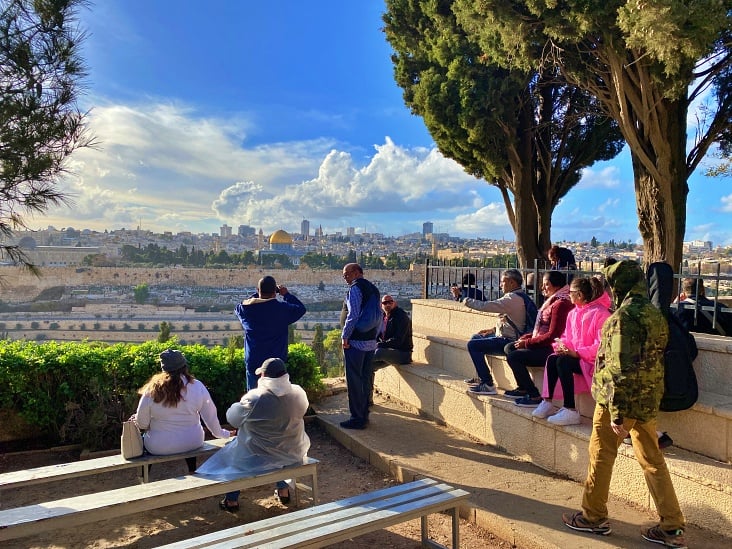
What’s the risk of childbirth at night in the cave? The sheep are placed in the innermost part of the cave. If the sheep discover the slightest light, it can confuse the animals to think it’s daylight and then run over the sleeping children, killing the little ones. It is also the same difficulty with the man whose neighbour comes to seek bread at night. The man must risk waking the animals if he enters the cave with light searching for bread. The animals would run over his sleeping children. How can it be ‘knocking on the door of a cave?’ Due to cultural differences, we can misinterpret the narrative of Biblical times.
What is the irony of the Shepherds?
The shepherds were considered unclean people in ancient times in Israel. They were in the mountains. There was less access to water for a bath and ritual purity. They found it difficult to practice Judaism as eating halal foods was not easy on the mountain terrain. The shepherds had one role in preparing the best lamb for sacrifice in the temple – the unblemished lamb.
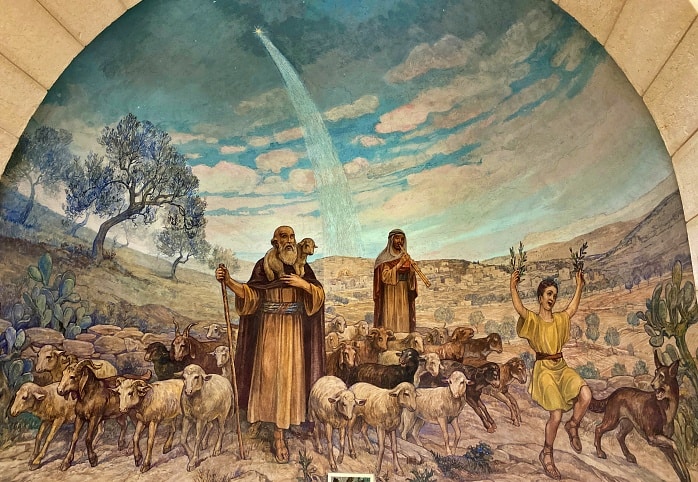
The irony! In a way, the unclean people are preparing clean lamps for temple sacrifice. Secondly, if anything significant is to happen in Jerusalem, the rich and powerful will hear about it first, and the ordinary people will discover it much later. But the announcement of the birth of Jesus was revealed first to the shepherds.
Corrected notions about St. Joseph
If not the carpenter, who was Joseph? Linguistic translations mess things up. According to the original word, Joseph was a builder, not a carpenter – more like an architect. But in those days, architects needed to know how to work with wood to fix things for the house. Recall Jesus using the metaphor of the cornerstone. As a professional builder, Jesus knew the quintessential place of a cornerstone.
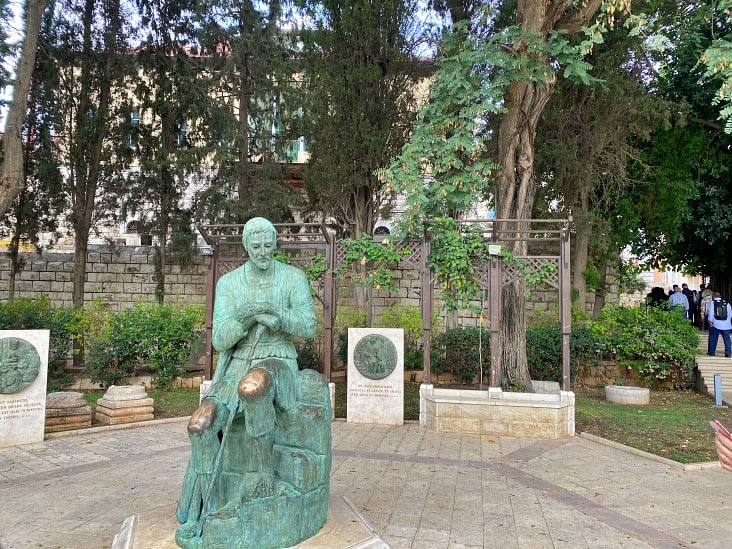
The world knows Joseph as a handsome young man. Contrary to it, Joseph was an older man. According to the cultural practice of the time, old Jewish men were allowed to marry young girls.
According to recent archaeological discoveries, Joseph was a rich man, not a poor worker. A ritual bath was found during the excavations of St Joseph’s home. The rich could afford exclusive baths in their houses for ritual cleansing before going to the temple for worship.
St. Joseph knows how to get the algorithms of your life correct without making much noise. What did you ask St. Joseph?
Anything good can come from Nazareth?
It is a wonder how an insignificant city became the biggest in the area. Nazareth was a tiny village over 2000 years ago. It is not even mentioned in the Old Testament. People used to make fun of the people of Nazareth. But it is mentioned in the New Testament. However, Jesus would be rejected in Nazareth and dragged towards a cliff to be hurled down. It was only after that incident Jesus moved to Capernaum.
“This is the place…?” I said as I moved out of a typical Jewish synagogue in Nazareth. As a young Jewish male, Jesus must have frequented the place to read from the scroll.
Today, Nazareth is the biggest city. But 2000 years ago, it was the smallest village in the area. There is no mention of Nazareth in the Old Testament. People used to make fun of people coming from Nazareth. You recall: What good can come from Nazareth?

Things you may not know about Cana
Jesus turns water into wine at a wedding feast in Cana. Where is this place today? Is it in Cana in Galilee or the other Cana found in present-day Lebanon? Archaeologists may debate the exact location of the miracle. But the miracle happened.
How is synagogue connected to Jesus’ miracle? In Hebrew, synagogue means a house – a place of teaching children about God’s word and traditions. But in Greek, synagogue implies a gathering place for weddings, funerals, etc. Ancient Synagogues were more a place of gathering for social events, including learning the Jewish sacred scriptures. Synagogues became a place of worship after the temple’s destruction in Jerusalem in 70 AD. During Jesus’ time, a synagogue was not a place of worship. The Jews believed that Jerusalem was the only temple to worship Yahweh. Now you will understand Jesus was a guest at a house for the wedding – it was a common gathering place, not a private home of a rich person.
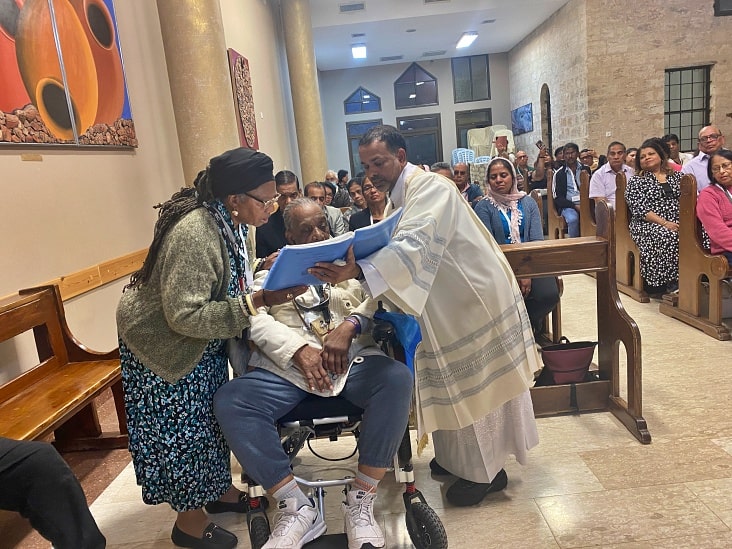
And should I talk about wine at Cana? Cana is not famous for grape wine. Most pilgrims buy grape wine from Cana in Galilee as a memento of remembrance. There is a higher chance that the wine must have been made of pomegranate juice. Cana is famous for pomegranates. It takes 40 kgs of pomegranate to produce one and a half litre of wine. The Israeli guide cautioned pilgrims to buy good wine, as he jokingly added, “Otherwise, you may have the second miracle of wine turning into juice when you get home.”
Only one miracle in Cana?
The Gospel of John records that Jesus’ first miracle is changing water into wine at the wedding feast at Cana in Galilee. But did Jesus perform more miracles in Cana? Yes, they are not recorded is the safest answer. John mentions that Jesus did so many miracles that all books in the world would not be enough to record them.
It was a surprise to know there was another recorded miracle in Cana. It was Jesus healing the Centurion’s servant. Jesus was in Cana when the Centurion asked Jesus to heal his servant by giving the order to heal. In Cana, Jesus pronounced healing of the Centurion’s servant in Capernaum. We were invited to offer prayers for the sick, as the distance is no barrier to healing miracles.
St. Peter’s Fish. Did you have it for lunch at Galilee?
The sea of Galilee has a variety of fish. So why is St. Peter’s fish so important? Because Peter found a coin in the mouth of the fish to pay taxes? The pilgrims can try their luck. According to Jewish tradition, a fish must have bone and scales to be edible. Sea fish varieties like Crabs and catfish are not halal (not clean for consumption). St. Peter’s fish is a particular variety of tilapia found in the sea of Galilee.
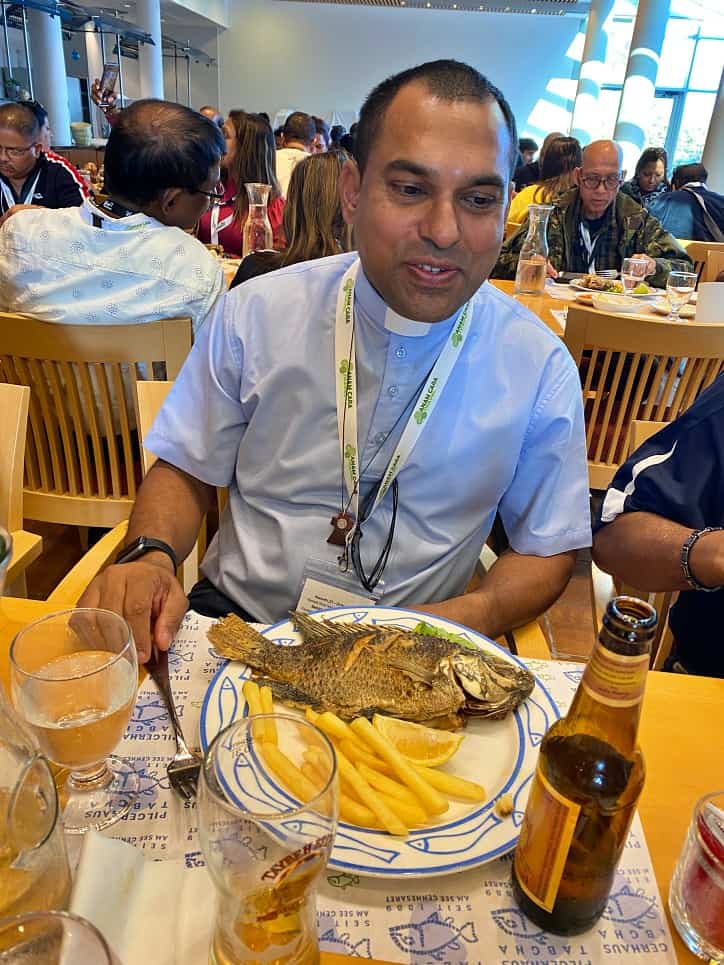
A unique phenomenon in the Holy Land is that the sea of Galilee is 212 meters below sea level. Another phenomenon is the valley where Jesus preached the Sermon on the mount. It is a natural amphitheatre with amazing acoustics that you can speak to a crowd without a microphone. You may not find these natural wonders anywhere in the world. River Jordan and the Dead Sea are other rivers below sea level.
Jericho! The oldest city on earth?
The city has a name of a Canaanite god of the moon – as it is often called, the city of the moon. According to the latest archaeological discovery of Jericho’s walls, it is the oldest city on earth. The walls of Jericho, dating 8000 BC, were from when humans shifted from food hunting to food gathering. The walls were not for defence but for agricultural purposes. Joshua will feature only in 1000 BC when the Levites crossed over into the promised land. The Levites crossed, carrying the arch of the covenant on dry land.
Jericho is the lowest city on earth, with an annual rainfall of 2-3 centimetres. Due to its high humidity, there is quick evaporation. The guide mentions a local saying, “if it snows in Jerusalem, you can go out in a bikini in Jericho.” The warm winters of Jericho remain its attraction for the rich and the famous – in ancient times, the mighty pitched their tents on the land of Jericho.
How are old public toilets connected to crucifixion?
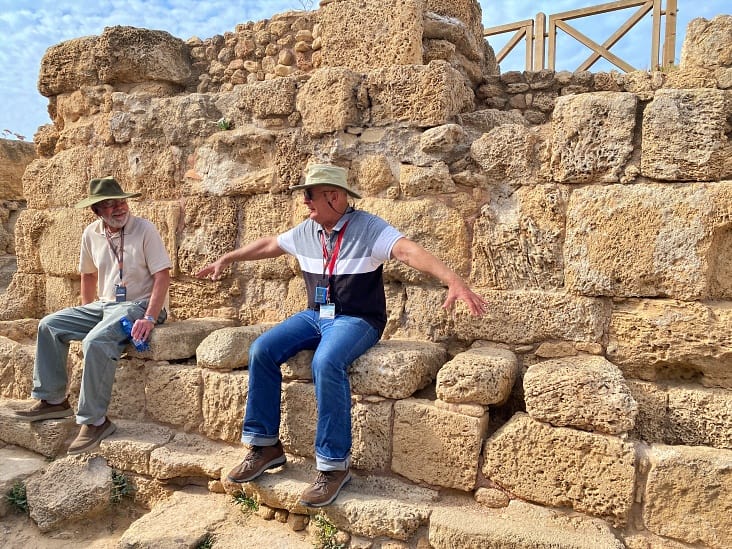
There were ancient Roman public toilets near an amphitheatre in Caesarea. Each person sat in a row, with no privacy but running water flowing beneath the stone seats. After the job was done, a slave used a stick with a sponge to clean the patron’s bum. During these times, such sticks were used to humiliate a person. While hanging on the cross, Jesus asked for water. The soldiers, to humiliate Jesus, used one such stick dipped in vinegar. It was a stick – a symbol of humiliation.
Bassam: The Smiling Guide
Our local Israeli guide Bassam says, “Holy Land has many names.” Indeed, the ancient land has witnessed divine intervention and human efforts for peace amidst turmoil and conflict.
Bassam explained the meaning of his name – as the one who is smiling. He compared himself to a shepherd of the group dealing with sheep and goats. While the sheep listens, the goats are challenging to get in line – keep the timing.
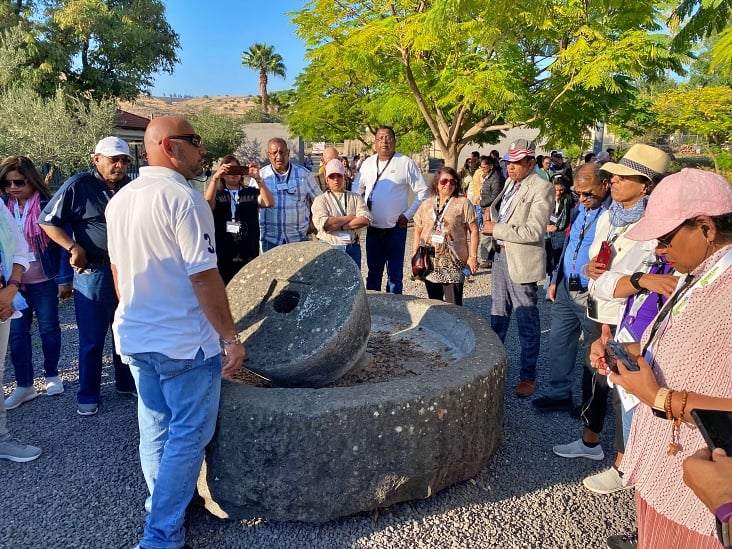
Our brother in Christ, Bassam made a counter-intuitive announcement regarding clicking photos: listen, see, touch and then take a picture. “There are more chances that you remember more about the photo than you start clicking photos first, and you forget the place of significance,” Bassam advised the pilgrims.
It was like a sermon on the bus – on the wheels. Bassam had a practical judgement in getting the pilgrims from one place to another. “No Stopping and No Shopping,” he said. “This is the golden rule about visiting the holy sites.”
“The important thing about pilgrimage is to forget about yourself and think about others,” Bassam emphasised.
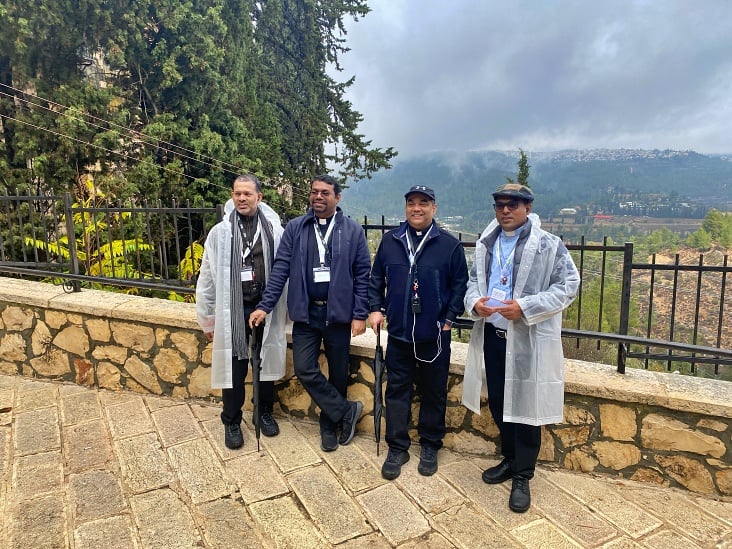
Notes I found interesting
An olive branch is a symbol of peace and a sign of life. The olive tree is green throughout the year. The olive tree appears not to die, as the shoot will emerge from the trunk. It is a symbol of continuous life.
The oldest mention of Bethlehem is in Genesis 35. The tomb of Rachel is a holy place for three religions: Jews, Christians and Muslims. Bethlehem in Hebrew means house of bread. And we have the classic text – Jesus is the bread of life.
Pilgrims acknowledge experiencing a sense of calm, peace and awe. Even with questionable historical accuracy, the holy land sites inspire pilgrims on the faith journey. New things continue to be born in life. Holiness is when Christ is among us.
About the Author
Feroz Fernandes, a Catholic Missionary, identifies himself as an Uncommon Priest. Father Feroz loves adventure in the apostolate. Check out his debut book The Uncommon Priest: Incredible Stories You Never Read on amazon. And also, the YouTube Channel: Feroz Fernandes promotes a better understanding of scripture.
My husband and I were privileged to be part of the Goan Chaplaincy UK Holy Land pilgrimage in November 2022 under the leadership of Fr Patrick & Fr Feroz. Fr Feroz has depicted our pilgrimage journey as though we are there again. It feels real. We can relive the day-to-day walking with Jesus with Fr Feroz’s narrative, which made it easy to read and riveting. Through this blog, Fr Feroz has given a written memento to keep alive our many photos and sermons delivered by you and Fr Patrick. Bonus from our youngest pride and joy pilgrim. Hats off to Bassam for a splendid job.
Thanks and Blessings. Pilgrimage is alive every time we recall the moments of grace during our faith journey.
Hi Fr Feroz, great blog and thanks for bringing to life my wonderful memories of the pilgrimage. Great recollections, reminder and photos of our spiritual journey and the whole team and spiritual leaders. Illustrating great listening to Bassam and acknowledging his knowledge as a superb guide.
It seems so far away yet fondly carried within my heart always.
Thanks, God bless and Merry Christmas, peace and joy always.
Lovely memories – all along. St. Peter’s fish and what amazing company I had at the table. Blessings to you all.